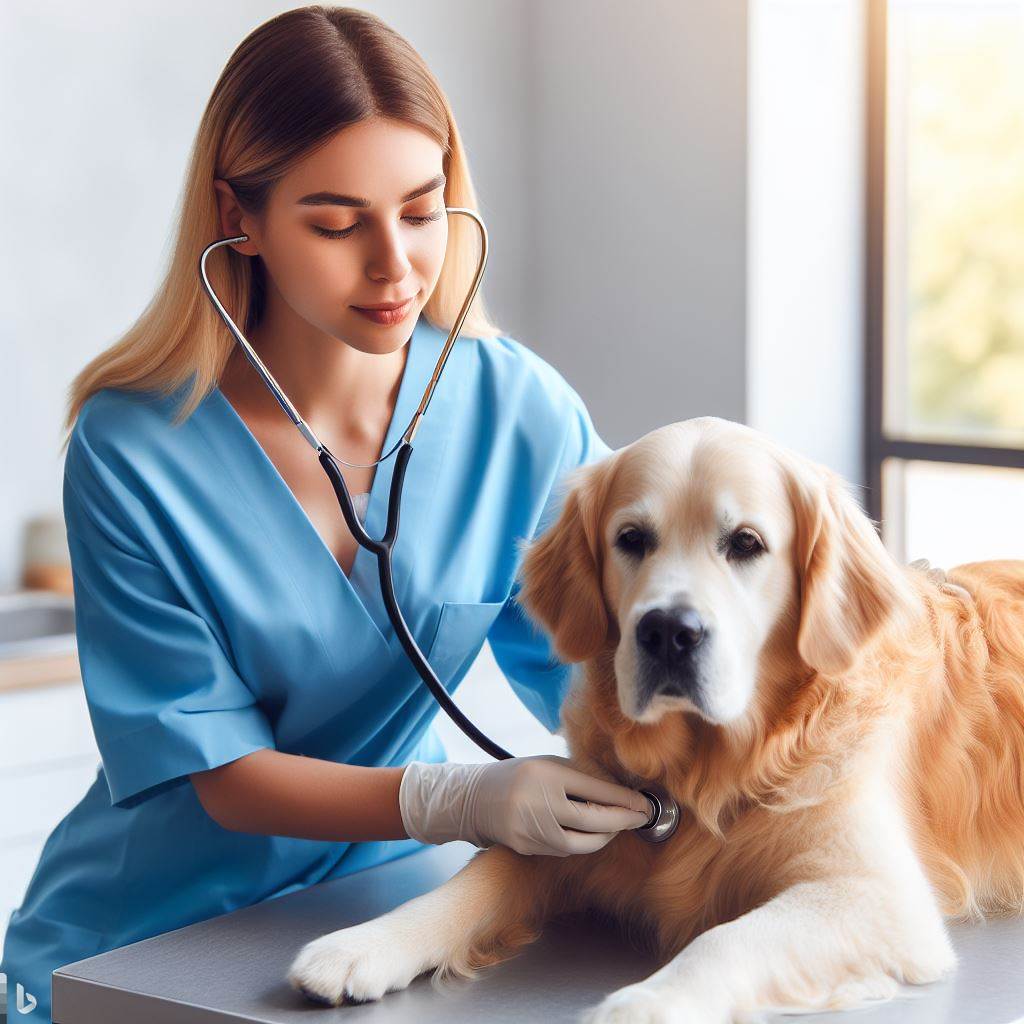Introduction
A. Importance of Veterinary Medicine
Veterinary medicine is vital not only for our beloved pets but also for safeguarding animal health, food safety, and even human well-being. It plays a crucial role in global health and the economy.
B. The Future of Veterinary Medicine: Trends & Predictions
In this section, we’ll explore the exciting possibilities that lie ahead in veterinary medicine.
The future promises remarkable advancements, from telemedicine for pets to the application of cutting-edge technologies in diagnostics and treatment.
We’ll also discuss how the profession is evolving to address emerging challenges, including zoonotic diseases and the growing awareness of animal welfare.
Join us in this journey into the future of veterinary medicine, where innovation and compassion converge to create a healthier, safer, and more sustainable world for all creatures great and small.
Current Landscape of Veterinary Medicine
A. The current state of veterinary medicine
- Veterinary medicine plays a crucial role in the overall well-being of animals, ensuring their health and providing necessary treatments.
- The field has seen significant advancements in technology, diagnostics, and medical procedures.
- Today, veterinarians have access to sophisticated equipment and tools that aid in accurate diagnoses and effective treatments.
- Veterinary medicine extends beyond pet care and now encompasses livestock, zoo animals, and even wildlife conservation.
- The demand for veterinary services has grown, with a rising number of pet owners and increased awareness about animal welfare.
- This has led to a greater need for highly trained and specialized veterinarians in various disciplines.
B. Key challenges and opportunities
- One of the key challenges faced by the veterinary profession is the cost of education and training.
- Veterinary school can be expensive, and many students graduate with significant debt, putting financial strain on their careers.
- Additionally, the shortage of rural veterinarians in some areas creates limited access to animal healthcare services.
- Another challenge is the emotional toll that comes with providing veterinary care, as veterinarians often have to make difficult decisions about euthanasia or treatment options.
- In terms of opportunities, technological advancements continue to shape the future of veterinary medicine.
- Telemedicine and remote consultations have become more common, allowing veterinarians to provide guidance and advice from a distance.
- Artificial intelligence and machine learning hold promise in enhancing diagnostics, predicting diseases, and improving treatments.
- Veterinary medicine is also exploring the use of regenerative medicine, such as stem cell therapy, for tissue repair and regeneration in animals.
- Collaboration with human medicine is gaining importance, as veterinarians and physicians work together to understand zoonotic diseases and their prevention.
- The growth of pet insurance presents an opportunity for veterinarians to provide better care without financial constraints.
- Education and public awareness campaigns about responsible pet ownership and preventive care can significantly improve animal health outcomes.
In summary, the current landscape of veterinary medicine is characterized by technological advancements, increased demand for services, and challenges related to education costs and access to care.
However, opportunities arise from the integration of technology in telemedicine and diagnostics, collaboration with human medicine, and the promotion of preventive care.
By addressing these challenges and leveraging these opportunities, the future of veterinary medicine holds great promise in providing the best possible care for animals.
Technological Advancements in Veterinary Medicine
A. Role of technology in transforming veterinary medicine
- Technology has revolutionized the field of veterinary medicine, improving efficiency, accuracy, and treatment outcomes.
- Veterinarians can now access a wide range of advanced tools and techniques to diagnose and treat animals.
- From digital imaging systems to robotic surgeries, technology has become an integral part of modern veterinary practices.
- It allows veterinarians to provide better care and ensure the well-being of their animal patients.
- Technology has also enabled veterinarians to collaborate and share knowledge globally to enhance veterinary practices worldwide.
B. Examples of innovative technologies used in veterinary practices
- Computed tomography (CT) scans and magnetic resonance imaging (MRI) provide detailed images for accurate diagnosis.
- 3D printers are used to create customized prosthetics and implants for animals in need.
- Laser therapy is employed to promote healing, reduce pain, and treat various conditions, including wounds and arthritis.
- Telemedicine allows remote consultations, helping veterinarians reach and treat animals in underserved areas.
- Virtual reality (VR) and augmented reality (AR) are utilized for training and simulation purposes.
C. Impact of technology on diagnostics, surgeries, and treatments
- Diagnostics: Technological advancements have significantly improved diagnostics in veterinary medicine.
- Advanced imaging techniques provide accurate and detailed visualizations of animals’ internal structures.
- High-tech laboratory equipment enables precise and rapid analysis of samples for various diseases.
- Advanced imaging techniques provide accurate and detailed visualizations of animals’ internal structures.
- Surgeries: Technology has transformed veterinary surgeries, making them less invasive and more precise.
- Minimally invasive procedures, such as laparoscopy and arthroscopy, reduce pain, scarring, and recovery time for animals.
- Robotic surgeries offer unprecedented precision and control, enhancing surgical outcomes.
- Minimally invasive procedures, such as laparoscopy and arthroscopy, reduce pain, scarring, and recovery time for animals.
- Treatments: Technology has expanded the treatment options available in veterinary medicine.
- Therapeutic laser systems provide pain relief, improve wound healing, and alleviate inflammation.
- Gene therapy and stem cell treatments hold promise for treating genetic disorders and regenerating damaged tissues.
- Targeted drug delivery systems ensure accurate dosing, minimizing side effects and improving efficacy.
- Technology also plays a significant role in monitoring and managing chronic conditions in animals.
- Therapeutic laser systems provide pain relief, improve wound healing, and alleviate inflammation.
The rapid advancements in technology have transformed veterinary medicine, improving diagnostics, surgeries, and treatments.
From advanced imaging techniques to robotic surgeries, veterinary practices have embraced innovative technologies to provide superior care to animal patients.
The impact of technology in this field cannot be overstated, as it enhances accuracy, precision, and collaboration.
With further advancements on the horizon, the future of veterinary medicine holds immense potential in improving animal health and welfare.
Read: The Evolving Role of Nurses in American Healthcare
Shift Towards Preventative Care
In recent years, the veterinary field has seen a significant shift towards preventative care.
This approach emphasizes the importance of keeping animals healthy rather than just treating them when they become sick.
A. Importance of Preventative Medicine
- Veterinary practices are recognizing the growing importance of preventative medicine.
- By focusing on prevention, veterinarians aim to reduce the occurrence of diseases and illnesses.
- Preventative care can lead to better overall health outcomes for animals, prolonging their lives.
B. Role of Nutrition, Vaccinations, and Regular Check-ups
- Nutrition plays a vital role in maintaining the health of animals.
- Veterinarians educate pet owners about the importance of a balanced diet for their pets.
- Proper nutrition can prevent obesity, improve immunity, and enhance the overall well-being of animals.
- Vaccinations are another critical aspect of preventative care.
- They protect animals from various infectious diseases, some of which can be life-threatening.
- Veterinarians recommend appropriate vaccination schedules based on the species, age, and lifestyle of the animal.
- Regular check-ups are essential to detect early signs of health problems.
- Through thorough examinations, veterinarians can identify potential issues before they become severe.
- Early intervention can prevent the progression of diseases and ensure better outcomes.
C. Benefits of Shifting Focus to Prevention
- Shifting the focus from treatment to prevention brings numerous benefits.
- Firstly, preventative care can save pet owners a considerable amount of money.
- Treating diseases and illnesses can be expensive, whereas preventing them is often more cost-effective.
- Additionally, preventative care reduces the emotional stress associated with having a sick animal.
- Pet owners can have peace of mind knowing that they are taking proactive measures to keep their pets healthy.
- Moreover, preventive medicine helps minimize the spread of contagious diseases within animal communities.
- Vaccinations, for example, not only protect individual animals but also contribute to herd immunity.
- By preventing diseases, veterinarians also contribute to public health and community well-being.
- Furthermore, the shift towards preventive care enhances the veterinarian-client relationship.
- Veterinarians can work closely with pet owners to develop tailored preventative care plans.
- This collaborative approach strengthens trust and improves communication between veterinarians and pet owners.
Essentially, the future of veterinary medicine is undoubtedly moving towards a greater emphasis on preventative care.
The importance of nutrition, vaccinations, and regular check-ups cannot be understated in preventing diseases and improving overall animal health.
Shifting the focus from treatment to prevention brings numerous benefits, including cost savings, reduced emotional stress, and improved public health.
It is an exciting time in the field of veterinary medicine as professionals continue to explore innovative ways to keep animals healthier for longer.
Read: Earnings Outlook: What to Expect as a Nurse in the USA
Telemedicine in Veterinary Medicine
Telemedicine has emerged as an innovative solution in the field of veterinary medicine, revolutionizing the way healthcare is delivered to animals.
With the advancements in technology, telemedicine is gaining popularity for its potential to enhance veterinary healthcare.
A. Introduction to Telemedicine and its Potential in Veterinary Healthcare
Telemedicine utilizes technology to provide remote healthcare services, allowing veterinarians to diagnose and treat animals without physical presence.
This virtual approach has immense potential in veterinary healthcare due to its convenience and accessibility.
Virtual consultations can take place through video calls or online messaging platforms, enabling pet owners to seek professional advice without the need for in-person visits.
This not only saves time and effort but also allows for immediate assistance in emergency situations.
B. Advantages and Limitations of Virtual Consultations for Pets
Virtual consultations offer several advantages for pets and their owners. Firstly, it eliminates the need for travel, reducing stress for both the animal and its owner.
This is particularly beneficial for animals that experience anxiety during vet visits.
Moreover, virtual consultations provide a cost-effective option for pet owners. They can avoid transportation expenses and reduce overall veterinary costs.
Additionally, this approach allows owners to seek guidance from specialized veterinarians who may not be available locally.
However, there are limitations to virtual consultations. In some cases, physical examinations are necessary for accurate diagnosis.
Certain conditions may require hands-on evaluation, making it challenging to rely solely on telemedicine.
Furthermore, technical issues or poor internet connectivity can hinder the effectiveness of virtual consultations.
C. How Telemedicine Can Improve Accessibility to Veterinary Care
One of the significant advantages of telemedicine in veterinary medicine is its ability to improve accessibility to veterinary care.
Many animals reside in remote areas where veterinary services are limited or inaccessible.
Telemedicine bridges this gap by allowing pet owners to connect with veterinarians from anywhere, eliminating the need for long-distance travel.
This is particularly beneficial for owners with limited mobility or those living in areas with a shortage of veterinary clinics.
Transform Your Career Today
Unlock a personalized career strategy that drives real results. Get tailored advice and a roadmap designed just for you.
Start NowFurthermore, telemedicine enables veterinary professionals to provide guidance to pet owners in real-time, ensuring timely interventions and reducing the risk of complications.
It also allows for follow-up consultations without the hassle of scheduling an in-person visit.
For pet owners with busy schedules, telemedicine offers the flexibility to seek veterinary advice at their convenience.
This ensures that minor concerns are addressed promptly, preventing them from progressing into more serious health issues.
In review, telemedicine has the potential to transform veterinary healthcare.
Despite its limitations, the advantages of virtual consultations for pets and increased accessibility to veterinary care make it an invaluable tool for the future of veterinary medicine.
Read: Continuing Education for Nurses: Why and How in the US?
Changing Client Expectations
A. Evolution of client expectations in veterinary medicine
Client expectations in the field of veterinary medicine have undergone significant changes over the years.
As pet owners become more informed and conscious about their pets’ well-being, they expect veterinary clinics to adapt and provide personalized care and services that conveniently meet their needs.
B. Desire for personalized care, convenient services, and alternative treatments
One of the major shifts in client expectations is the growing desire for personalized care.
Pet owners want veterinary professionals to treat their pets as individuals and tailor healthcare plans to their specific needs.
This trend emphasizes the importance of understanding the unique characteristics and medical history of each animal to provide effective and customized treatments.
Furthermore, convenience plays a crucial role in client expectations.
Pet owners nowadays lead busy lives and value veterinary clinics that offer flexible appointment options, extended hours, and online services for booking appointments, accessing medical records, and ordering prescription refills.
By providing convenient services, veterinarians can enhance client satisfaction and ensure regular and timely care for pets.
In addition to personalized care and convenience, the demand for alternative treatments has been increasing.
Pet owners are increasingly turning to holistic or natural remedies, acupuncture, chiropractic care, and herbal medicine as potential alternatives or complements to traditional veterinary therapies.
Veterinary practices that offer a range of treatment options, including these alternative approaches, can attract and retain clients seeking a broader spectrum of care for their pets.
C. Importance of effective communication with pet owners
To meet these changing client expectations, effective communication with pet owners is paramount.
Veterinarians must be able to explain complex medical information in a way that is easy for pet owners to understand.
Clear and transparent communication instills trust, helps clients make informed decisions about their pets’ care, and fosters a strong veterinarian-client-patient relationship, which is crucial for the well-being of the animal.
Moreover, veterinary professionals should actively listen to pet owners’ concerns, questions, and preferences to provide comprehensive care that aligns with the clients’ values and expectations.
Showcase Your Business Today
Reach thousands of readers actively exploring professional services. Publish your business profile and grow your audience now.
Publish NowListening to feedback and continuously improving communication practices ensures that clients feel heard, valued, and involved in the decision-making process regarding their pets’ healthcare.
In fact, the future of veterinary medicine will be shaped by the evolving expectations of clients.
To stay ahead, veterinary clinics must prioritize personalized care, convenient services, and alternative treatments while maintaining effective communication with pet owners.
By adapting to these trends, veterinarians can provide comprehensive and quality healthcare, ultimately benefiting the well-being of animals and strengthening the bond between pet owners and veterinary professionals.
Read: The Pros and Cons of Travel Nursing Across States

Increased Emphasis on Specialized Fields
A. Growth of Specialized Fields Within Veterinary Medicine
- Veterinary medicine is evolving rapidly, with a notable trend being the substantial growth of specialized fields.
- These specialized fields allow veterinarians to focus on specific areas, such as dermatology, cardiology, and oncology.
- Specialization is driven by advancements in knowledge and technology, enabling more precise diagnosis and treatment.
- Canine rehabilitation, veterinary dentistry, and wildlife medicine are some examples of burgeoning specialties.
B. Impact of Advancements in Research and Specialization on Patient Care
- Advancements in specialized fields result in better patient care, with a focus on tailored treatment plans.
- Specialized practitioners can provide in-depth expertise, leading to improved outcomes for animal patients.
- Cutting-edge technologies like MRI and specialized surgical techniques enhance diagnostic and treatment capabilities.
- Animal welfare benefits from these advancements, with better pain management and faster recoveries.
C. Importance of Collaboration and Knowledge Sharing Among Veterinary Professionals
- Collaboration and knowledge sharing among veterinary professionals have never been more critical.
- Sharing research findings and case studies across specialties fosters a holistic approach to patient care.
- Multidisciplinary teams with diverse expertise ensure well-rounded treatment strategies for complex cases.
- Veterinarians, veterinary technicians, and researchers must collaborate to advance the field collectively.
- Cross-specialty communication is vital for early disease detection and effective prevention strategies.
- Continuous education and conferences that encourage knowledge exchange are essential for staying updated.
- Online platforms and forums enable professionals to share experiences and discuss best practices.
- Interdisciplinary teamwork provides a comprehensive approach, benefitting both common and rare cases.
To summarize, the future of veterinary medicine revolves around the growth of specialized fields.
This emphasis on specialization leads to better patient care, thanks to cutting-edge advancements and collaboration among veterinary professionals.
As these trends continue, the field will undoubtedly evolve, improving the well-being of our beloved animal companions.
See Related Content: Steps to Become a Rehabilitation Counselor
The Role of Data Analytics in Veterinary Medicine
Data analytics has become an essential tool in various industries, and veterinary medicine is no exception.
By harnessing the power of data, veterinarians can enhance patient care, make informed decisions, and predict trends for better healthcare outcomes.
In this section, we will explore the role of data analytics in veterinary medicine, its benefits, and the ethical considerations surrounding data usage.
A. Utilization of data analytics to improve patient outcomes
In the field of veterinary medicine, data analytics can play a vital role in improving patient outcomes.
By analyzing large datasets of animal health records, veterinarians can identify patterns and trends to understand the effectiveness of different treatments.
This information can be used to develop evidence-based protocols and refine treatment plans for better patient care.
Data analytics also enables veterinarians to track the progress of patients over time. They can monitor various parameters such as vital signs, medication dosages, and laboratory test results.
By analyzing these data points, veterinarians can identify potential complications or adverse reactions, allowing for timely interventions and personalized treatment plans.
B. Benefits of data-driven decision-making and predictive analytics in veterinary practices
Data-driven decision-making empowers veterinarians to make informed choices based on evidence rather than relying solely on intuition or experience.
By analyzing historical data, veterinarians can identify patterns and correlations that may not be apparent otherwise.
This can lead to more accurate diagnoses, optimized treatment plans, and improved patient outcomes.
Additionally, predictive analytics in veterinary medicine can help veterinarians anticipate potential health issues and take preventative measures.
By analyzing past data and applying machine learning algorithms, veterinarians can predict disease outbreaks, identify high-risk individuals, and intervene before an illness becomes severe.
This proactive approach can save lives and improve overall animal welfare.
C. Ethical considerations and privacy concerns surrounding data usage
While the use of data analytics offers numerous benefits, it also raises ethical considerations and privacy concerns.
Veterinary practices must ensure that the data collected is obtained with proper consent from pet owners and anonymized to protect individual privacy.
Additionally, strict data security measures should be in place to prevent unauthorized access and misuse.
Another ethical consideration is the potential for bias in data analytics. The algorithms used in data analysis may have inherent biases, leading to unequal treatment or inaccurate predictions.
Veterinarians and data analysts must be aware of these biases and take steps to minimize their impact on decision-making and patient care.
To sum it up, data analytics plays a crucial role in veterinary medicine by improving patient outcomes, enabling data-driven decision-making, and predicting trends.
However, ethical considerations and privacy concerns need to be addressed to ensure responsible and unbiased use of data.
As technology advances, the integration of data analytics into veterinary practices will continue to revolutionize the field, leading to better healthcare for animals.
Environmental and Animal Welfare Concerns
In the ever-evolving field of veterinary medicine, there is an increasing recognition of the crucial link between animal and environmental health.
This awareness has led to a significant shift in how veterinary professionals approach their work.
Veterinary medicine has started to recognize its role in sustainability and conservation efforts.
As the impact of human activities on the environment becomes clearer, veterinarians are stepping up to protect both animals and their habitats.
Advancements in veterinary care have enabled professionals to address animal welfare concerns more effectively.
With new technologies and treatments, veterinarians now have the means to provide better care and alleviate animal suffering.
A. Recognition of the link between animal and environmental health
- Veterinarians now understand that the well-being of animals and the health of the environment are intertwined.
- Animals depend on clean environments for their survival and overall health.
- Environmental degradation, such as pollution and habitat destruction, directly impacts animal populations.
- By protecting the environment, veterinarians can safeguard the health and well-being of animals.
B. Veterinary medicine’s role in sustainability and conservation efforts
- Veterinary professionals have started actively participating in sustainability and conservation initiatives.
- They contribute to preserving endangered species and protecting delicate ecosystems.
- Veterinarians collaborate with environmental scientists and organizations to develop strategies for habitat restoration and conservation.
- They promote the use of eco-friendly practices in animal care and encourage responsible pet ownership.
- By reducing the environmental footprint of veterinary practices, they aim to minimize the profession’s impact on the planet.
C. Addressing animal welfare concerns through advancements in veterinary care
- Veterinary care has come a long way, and animals now receive more compassionate and comprehensive treatment.
- Veterinarians have access to improved diagnostic tools and more efficient treatment options.
- Advancements in anesthesia and pain management ensure that animals undergo procedures with minimal discomfort.
- Veterinarians utilize cutting-edge surgical techniques to minimize recovery time and enhance postoperative care.
- With ongoing research, veterinarians are developing innovative therapies to tackle complex animal welfare issues.
In general, the future of veterinary medicine emphasizes the importance of environmental and animal welfare concerns.
Veterinarians acknowledge the intricate relationship between animal and environmental health.
They actively engage in sustainability efforts, contribute to conservation initiatives, and promote eco-friendly practices.
Furthermore, advancements in veterinary care enable better treatment and address animal welfare concerns effectively.
These developments pave the way for a brighter future, where animals thrive in a healthier and more sustainable environment.
Delve into the Subject: Top Rehabilitation Counseling Programs
Conclusion
Recapping the main points discussed, the future of veterinary medicine is filled with promising trends and predictions.
It is crucial for the industry to embrace these changes.
By leveraging advancements in technology, such as telemedicine and AI, veterinary practices can improve efficiency, offer better care, and reach more pet owners.
Additionally, the increased focus on preventive medicine and holistic approaches will ensure healthier and happier animals.
As the demand for veterinary services continues to grow, it is essential for veterinarians to adapt and stay ahead of the curve.
Embracing these trends and predictions will not only benefit individual practices but also contribute to the overall advancement of veterinary medicine.
In the end, the future of veterinary medicine holds great potential, and those who are willing to embrace change will thrive in this ever-evolving field.
[E-Books for Sale]
The Big Book of 500 High-Paying Jobs in America: Unlock Your Earning Potential
$19.99 • 500 High-Paying Jobs • 330 pages
Explore 500 high-paying jobs in America and learn how to boost your career, earn more, and achieve success!
See All 500 High-Paying Jobs of this E-Book
1001 Professions Without a Degree: High-Paying American Jobs You Can Start Now
$19.99 • 1001 Professions Without a Degree • 174 pages
Discover 1001 high-paying jobs without a degree! Unlock career tips, skills, and success strategies for just $19.99!




